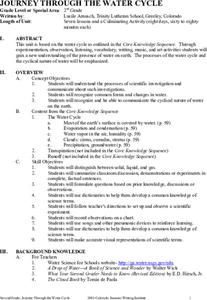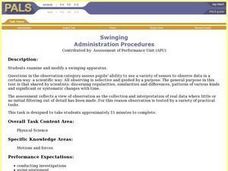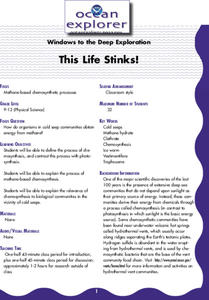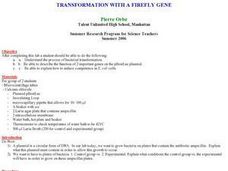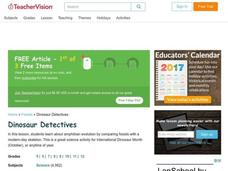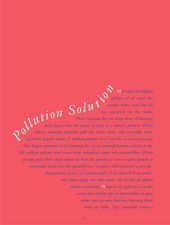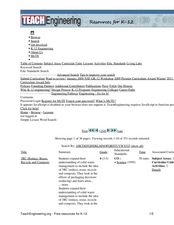Curated OER
Meiosis
Students practice identifying the stages and purpose for meiosis. They use a worksheet to construct each phase, label its parts and describe the process occurring in each phase. they divide the process into meiosis I and meiosis II.
Curated OER
Journey Through the Water Cycle
Students canvass the water cycle in the seven lessons of this unit. The processes of the water cycle and the cyclical nature of water is emphasized inthis unit.
Curated OER
Swinging Observations
High schoolers build a pendulum type swinging apparatus and make specific and selective observations using what they know about scientific observations. They look for regularities of movement, patterns, and systemic changes over time.
Curated OER
What was Newton's Idea of Science?
Students form logical foundations for analysis of observations. They improve analytic reading abilities through practice. Students investigate the foundations of scientific thought processes and how to apply them.
Curated OER
This Life Stinks!
High schoolers explore the process of chemosynthesis and contrast this process with photosynthesis. They consider the relevance of chemosynthesis to biological communities in the vicinity of cold seeps.
Curated OER
Earth Surface Socratic Questions
High schoolers explore the ways Earth's surface is shaped by hydrologic, climate and tectonic forces by participating in a whole class discussion. They respond to prompts that lead them to conclusions about the relationships between...
Curated OER
Transformation With A Firefly Gene
High schoolers understand the process of bacterial transformation through experimentation. They describe the function of two important genes of the pBestLuc plasmid. They explain how to induce competence in E. coli cells.
Curated OER
Antisense Oligonucleotide Therapy
Students conduct Internet research on Antisense Oligonucleotide Therapy. They design a puzzle to represent these processes, read and summarize an article, conduct research, and design a theoretical experimental procedure.
Curated OER
Dinosaur Detectives
Students examine amphibian evolution by comparing fossils with a modern-day skeleton. They experience the scientific thought process of drawing conclusions from limited paleontological data. Student groups align the figures with the...
Curated OER
Choices Affect the Environment-I Make a Difference
Students examine and research how personal and societal choices can affect the environment. Student find resources that provide scientific research about the possible impact of each of the choices. Students then create a four-panel...
Curated OER
Up, Up and Away
Third graders are presented with the problem of: Do all liquids evaporate at the same rate? The lesson contains adequate background information for the teacher. They participate in a lab experiment in order to test the scientific...
Curated OER
Plants Under Attack
Third graders will identify the four needs for plant survival and gain skills and confidence in using scientific measurement tools, probes as well as the spreadsheets and graphing capacity of a computer to represent and analyze data.They...
Curated OER
Building a Better Mousetrap
Eighth graders are introduced to the "Design Process" for technological development by constructing a prototype of a humane mousetrap. Students must record the steps their design groups go through while designing their prototypes and...
Curated OER
It's Fun to Learn!
Students use the macro mode of the OLYMPUS FE-140 CAMERAS as virtual microscopes to explore different habitats, observe plants, soil, and insects and other creatures. They download those images on electronic files and build web pages....
Curated OER
Open Wide and Trek Inside!
Students explore, examine and study a module that focuses on the science of the oral environment and major scientific concepts relating to oral health. They investigate the process of tooth decay by interacting with stories and games...
Curated OER
Types of Forces
Young scholars study scientific names and descriptions of forces. In this motion lesson students organize information into a graphic organizer then teach it to other young scholars.
Curated OER
Photosynthesis and Respiration
Eighth graders differentiate photosynthesis and respiration. For this biology lesson, 8th graders draw a diagram explaining these two processes. They answer a quiz after the lesson.
Curated OER
DNA and RNA
Tenth graders research the history and discovery of DNA. Using their text, they label a basic DNA structure and the composition of genes. They explain how RNA and DNA differ from one other and discuss the processes of transcription and...
Curated OER
Pollution Solution
Fourth graders examine how trees help to absorb the pollution that is emitted from automobiles. They review the process of photosynthesis and determine how forest management is important on their reservation. They think about the...
Curated OER
From Molecules to Mole Day Do's
Students recognize methods used to define the mole. After converting various quantities to the mole, students provide a context for understanding the usefulness of scientific notation and the mole.
Curated OER
Introduction to Worm Bin Project
Young scholars observe the decomposing process of the food chain in a worm bin. They observe whether the type of food fed to worms affect the castings given off during the decomposition process. They learn and practice graphing their...
Curated OER
Science Experiments with Eggs
ESL students experiment with eggs to learn the science concepts and science process language.
Curated OER
Lobby Groups And Their Role In The Democratic Process
Students explain the role of the different players in the process of lobbying the government for changes in policy and or law. They select an issue of current concern and determine who their contacts would be both inside and outside of...
Curated OER
Where's the Water?
Fifth graders conduct an investigation into water purification during a role play situation in an Amazon Rainforest. They design a scientific experiment for cleaning and filtering water.



